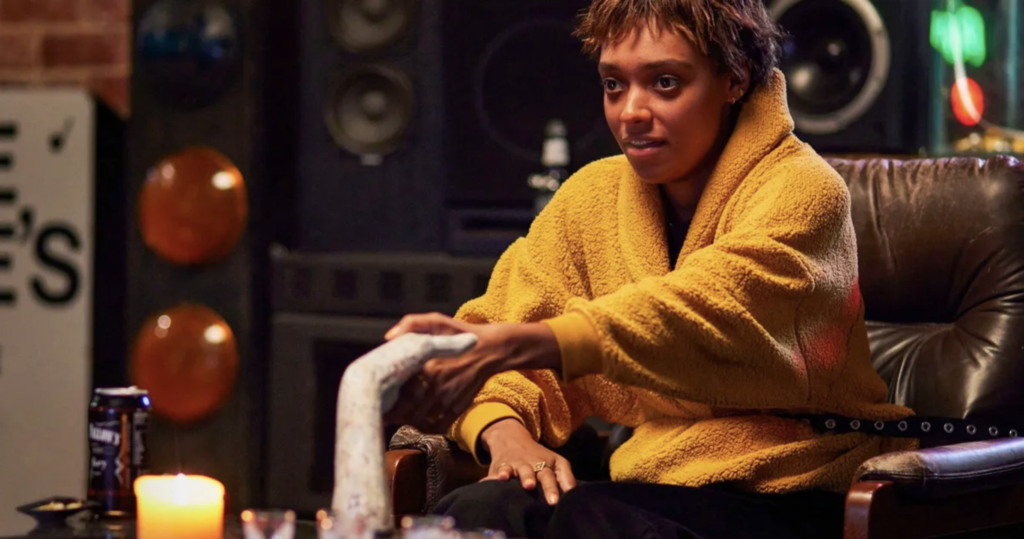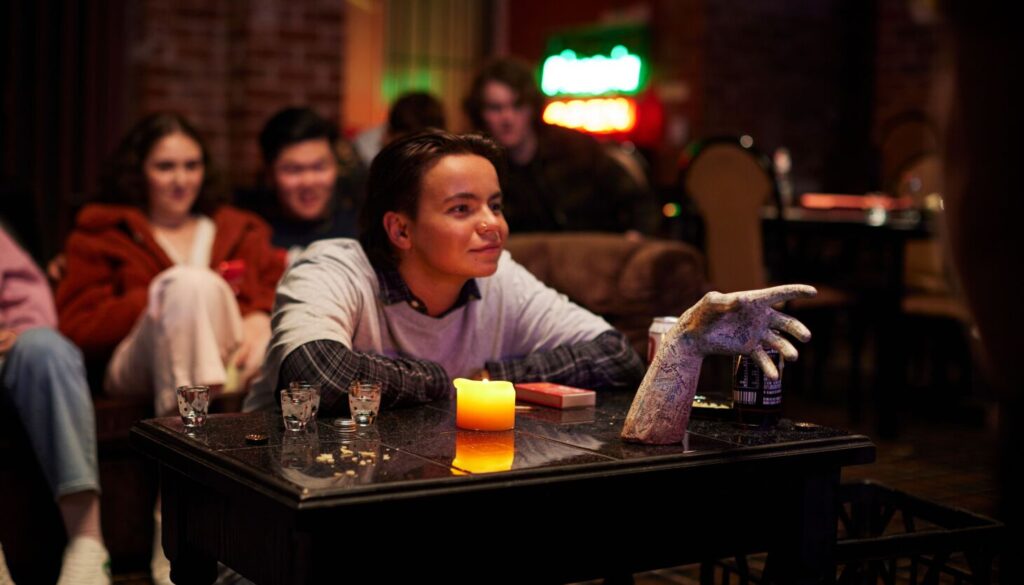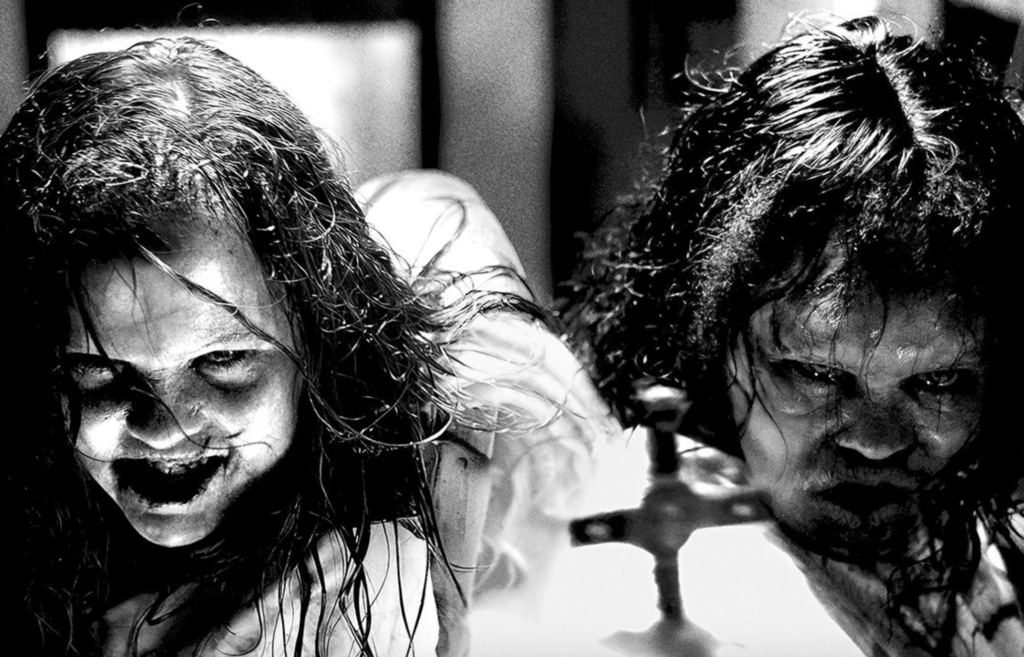
So I’m sitting there watching Talk to Me, the A24 Australian horror movie you might have seen the trailer for. It’s the one where a bunch of teenagers are in a basement and one of them holds a hand statue and then goes into some sort of trance.
The movie is pretty good. But it made its fair share of screenwriting errors. Basically, the plot goes like this. A teenage girl, Mia, hangs out with this family all the time because her mom died. She’s got her friend, Jade. And then Jade’s younger brother, Riley.
This trio occasionally hangs around a cool group at school, led by tough-chick Hayley, and Hayley’s muscle, Joss. This group loves to play this game called, “Talk to Me,” where they bring out a hand statue, strap you into a chair in front of it, you hold the hand and say, “Talk to me,” then follow that by saying, “I let you in.”
As soon as you say, “I let you in,” whoever’s in the chair sees a [usually gruesome] dead person sitting in front of them. Nobody else in the room can see this. Just the person in the chair. This creates a level of doubt where everyone can write the experience off as fake, much like when two people push the planchette on a Ouija board. You can always blame the other person as the pusher.
Except everyone in the room participates in the experience so that sort of negates the idea that they’re faking it. But we’re not going to nitpick.
Mia seems particularly affected by her experience, where she saw a couple of gnarly dead bodies. But it’s when Riley goes under that the crap hits the air conditioner. Riley is channeling Mia’s dead mother.
Mia is so taken by the chance to talk to her mom that she prevents Riley from stopping the experience before the mandatory 90 seconds. Riley starts going ballistic, bashing his head into anything he can find, nearly killing himself before they’re able to detach the hand from him.
This results in Mia being banished from the family, which sends her back home to hang out with her dad. When Mia sees her mother’s apparition again, she finally answers the question about whether she killed herself. She didn’t. And the person who did is two rooms away from her. Her father. Time to run.

You may have snooped out a couple of the screenwriting issues from that synopsis. The first is that the possession rule is shaky. In fact, we’re not even sure people are being possessed for three-quarters of the movie. Mia is not possessed despite going through the process. She sees other spirits, like her mom. But she’s not possessed.
Then, near the end, we lean heavily into the injured Riley being possessed. And then, of course, Mia’s father being possessed. Whoever’s inside of her dad is trying to kill her.
You can tell that the writers started to realize near the end of writing the screenplay that, “Oh, they’re possessed! So we can do something with that!” So then they rush to pay off a possession storyline that they never really set up.
It’s fine to do this. It’s a natural part of screenwriting. You figure things out while you’re writing the script. But once you figure something big out, you have to go back and properly set it up.
Ditto the dad. They didn’t even mention the dad for the first 70% of the movie! I didn’t know she had one. How could I? She was always at this other house. And the writers leaned heavily into this idea that this other family was taking care of Mia. So we assumed she didn’t have family.
To not only tell us she had family, but to build the crux of Mia’s entire storyline around what her father did to her mother was clunky to say the least. A good screenwriter is going to realize that if they want to use this ending, they need to go back into that first act and properly set up the dad. Then keep him in the story throughout the second act.
As I was pondering all this, a question popped into my brain: Does it matter? Or, more specifically, would this have mattered in regards to how well the movie did? It’s got a 94% critic score on Rotten Tomatoes. It’s got an 82% audience score. It made 50 million dollars in the U.S. and nearly 90 million worldwide.
Would making those changes have affected these numbers in a positive way? Because if you look just at the movie, it’s really well put together. The main actress who plays Mia, Sophie Wild, is great. She’s going to become a star. The rest of the cast is really good. There are no weak links.
The cinematography is great. The directing overall has no weaknesses (they were particularly convincing in creating a “teenage atmosphere”). Also, the hand sequence WORKS. Whatever it is at the center of your fantastical story, it has to be convincing for the viewer to suspend their disbelief. If it’s hokey or dumb, they’ll immediately check out. And the “talk to me” stuff was perfect.
Most importantly, the movie was scary. I did the thing where I put my arms up in front of my face half-a-dozen times cause I saw something weird in the corner and it started moving and I didn’t want to know what the f*** it was.
So, if you do those things: You have a convincing mythology, you have plenty of legitimate scares, you have characters who we’re on board with – you can make screenwriting mistakes and it be okay. It’s similar to what I tell comedy writers. If your script is funny, you can have the worst plot ever. It doesn’t matter. Ditto with horror. If it’s scary, you can make mistakes.
But the purist in me still believes that if you fix those mistakes, your movie is going to have better word-of-mouth which means more people are going to want to see it. I think it’s telling that the audience score is lower than the critical score here. Audiences may have been a little frustrated by the sloppiness in the storytelling.

Look no further than what happened to Exorcist: Believer this weekend. Now I didn’t see the film. But I knew that the baseline they were building predictions off of was 30 million. Because that’s what the predicted ROI was for this particular advertising package. Now, the box office could go well above that number or below it. And it depended on if the story was good.
Guess what?
It wasn’t good. It has a 22% Rotten Tomatoes score and a 59% Audience score (which will probably go down once more reviews come in). It was made clear early on on social media that this one was a stinker. And so all those potential moviegoers who were thinking about going on Saturday who were going to pump up that box office to the high 30s, maybe even 40 million dollars, they decided to stay home, and the movie made 27 million bucks.
In David Gordon Green’s defense, I’ve never been able to figure out the key difference between an exorcism movie that works and one that doesn’t. For all intents and purposes, the original Exorcist should not have worked. It’s long. We’re stuck in this house the whole time. Some characters disappear for 90% of the movie. Others show up halfway into the movie.
I just remember that movie feeling so real. It felt like how an actual exorcism situation would happen. That realism is what sold it for me. And even though all these exorcism movies since have given us convincing possession performances, none of them has felt as authentic as The Exorcist.
In other words, trying to recreate the authenticity of one of the most authentic horror movies ever is a hard task to pull off. None of the other Exorcist sequels have been able to do it. I’m shocked, like the rest of the industry, that Universal paid 400 million for the rights to try and change that pattern. A lot of people thought they were dumb. Believer’s critical and audience reception is proving them right. It looks like this franchise is going to end up on the bottom of a concrete stairway.

